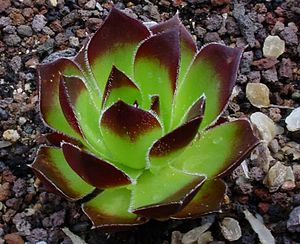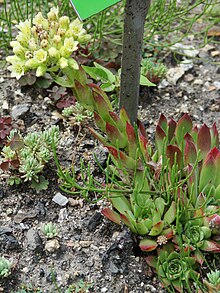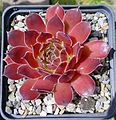Sempervivum heuffelii
| Sempervivum heuffelii | ||||||||||||
|---|---|---|---|---|---|---|---|---|---|---|---|---|

Sempervivum heuffelii |
||||||||||||
| Systematics | ||||||||||||
|
||||||||||||
| Scientific name | ||||||||||||
| Sempervivum heuffelii | ||||||||||||
| Bulkhead |
Sempervivum heuffelii also Balkan Frans Hauswurz called, is a plant of the genus sempervivum (Houseleeks) in the family of saxifrage-like (Saxifragales). The epithet of the species honors the Austro-Hungarian botanist János A. Heuffel (1800–1857).
description
Sempervivum heuffelii grows with very flat, open, downy-haired or bald rosettes 3 to 12 centimeters in diameter. Usually a diameter of 4 to 8 centimeters is recorded. In cultivation , a rosette diameter of 15 to 18 centimeters can be achieved with high nutrient inputs. Its roots are thick, branched or lobed. The spreading leaves , convex on both sides, are mostly light or dark green or frosted green, but also vary in brown and red tones. The oblong obovate leaf blade is 20 to 60 millimeters long and 10 to 15 millimeters wide. A thorn tip is attached to the tip of the leaf. The leaf margins are occasionally white. The leaves can have bare, but also finely hairy leaf surfaces to varying degrees. Bare leaf surfaces are more common than hairy ones.
The flower shoots reach a length of 10 to 20 centimeters. The densely zymous inflorescence consists of three forked coils. The flowers are six to seven-fold. Their pointed, linear to lanceolate, greenish-yellow sepals are often red-pointed. They are 6 to 10 millimeters long and grown together to around 2.5 millimeters. The yellow or yellowish white, upright petals are oblong obovate, usually three-pointed and keeled. They are ciliated, hardly fringed and 10 to 12 millimeters long. The stamens are light yellow, the stamens deep yellow. The relatively strong stylus is about 2 millimeters long. The greenish nectar flakes are square to rounded.
The vegetative reproduction occurs apparently via "rosette division": The few offshoots develop sitting and arise very close to the tip of the shoot.
The pear-shaped seeds are quite wide.
The chromosome number is .
Systematics and distribution
Sempervivum heuffelii is widespread in the east of the Carpathian Mountains and the mountains of the Balkan Peninsula . The species specializes in limestone soils, but is also found in exceptional cases on silicate substrates.
The first description was in 1852 by Heinrich Wilhelm Schott . Sempervivum heuffelii is placed in the Jovibarba section within the genus Sempervivum . Nomenclatory synonyms are Diopogon heuffelii (Schott) Jord. & Fourr. (1868) and Jovibarba heuffelii (Schott) A.Löve & D.Löve (1961). One of the other numerous synonyms is Sempervivum kopaonikense Pančić (1874) .
use
Many varieties were bred from the very variable species. In addition, various forms of locality are cultivated. In cultivation there are also crosses with the species Sempervivum globiferum ( Sempervivum × nixonii ), which also belongs to the Jovibarba section .
literature
- Urs Eggli (ed.): Succulent lexicon. Crassulaceae (thick leaf family) . Eugen Ulmer, Stuttgart 2003, ISBN 3-8001-3998-7 , pp. 357 .
- Martin Haberer, Hans Graf: 500 hardy succulents and cacti from A - Z . Stuttgart 2010, ISBN 978-3-8001-5487-6 , pp. 42-55.
Individual evidence
- ↑ Austrian Botanical Weekly Journal. Non-profit organization for botany . Volume 2, Vienna 1852, p. 18.





